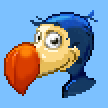Well, this is all i found RE: shaders in Bastioni Lab...
Looks like its for Blender Cycles. But it does describe the purpose of some of the textures. Unfortunately i'm not up to speed on all the latest character rendering techniques. so i can't just look at them and go "oh! ok, just do this and that..."
===================================== From the online docs ======================================
Define the skin and textures
From version 1.3.0, ManuelbastioniLAB provides a poweful skin editor.
Behind the simple interface there is a set of complex shaders for human skin, human eyes, toon skin and toon eyes. These shaders are developed in order to simulate the variety of skin tones and work under any lighting condition.
- An advanced human skin shader
- An advanced toon skin shader
- Shaders for eyes
The skin editor is visually divided in three parts:
- Bump/displacement controls
- Parameters editor
- Save textures controls
Bump/displacement controls

The button "Update displacement" is the gui for the displacement system, an algorithm that automatically creates the bump map from the values of age, mass and tone parameters. For example, an older character will have more wrinkles, while a muscled character will have more noticeable veins.
You should use this button to update the bump/displacement each time you change the meta parameters.
Using Cycles in realtime, some time the viewport is not updated with the recalculated bump.
The button "Enable displacement preview" will show the displacement directly in the viewport, in realtime. Anyway, since usually the displacement is matter of little details, it's also required to press the button "Enable subdivision preview". This button subdivides the model in realtime, so it has enough resolution to show the displacement effects.
Subdivision in realtime is very CPU consuming and should be used only for a quick preview.
Parameters editor
The parameters editor is composed by an intuivive set of sliders for easily modify the values of skin complexion, skin bump, skin oil, skin saturation, skin subsurface scattering and more. The editor also provides controls for the eyes hue, tone and saturation.
One of most important parameters is the complexion. It modifies the color in order to vary from very light skin to very dark one. It's not just the brightness, but a complex result obtained using the samples from an image included in the lab data.

The skin model used in the shader is composed by two layers, the subdermal (veins and muscles) and the dermal (external skin): the variety of the human skin tone on the body is mostly determined by the interaction of these two layers. ManuelbastioniLAB 1.3 provides two parameters to control them: the skin_subderm and the skin_saturation.
The skin_subderm controls the thickness of the dermal layer. Low values are for very thin and transparent dermal layer that shows the reddish subdermal. High values are for thick and dense dermal that is more opaque and creates less light scattering.

The parameter skin_saturation controls the color saturation of the dermal layer. This parameter, combined with the complexion, permits to cover practically any human skin tone.

Another important factor is the amount of the oil layer. It's a thin layer that protects the skin, more noticeable in some body parts and almost invisible in others. In lab 1.3 it's assumed an uniform distribution of the oil. More accurate controls will be added in future releases.

Save textures controls
Each time the button "Update displacement" is pressed, the system recalculates the displacement map using the values of meta parameters. This map can be saved with the "Save displacement image" button, in order to be usable in external engines or infinalized characters.
The dermal and subdermal textures can be saved too, using the dedicated buttons.
|Back to index|




















